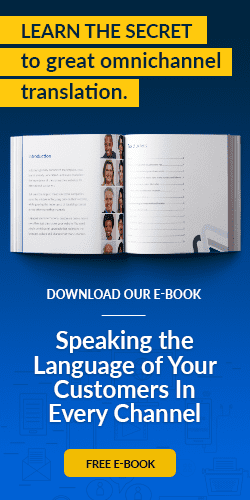Many companies serve their global customers with translated websites, but often fail to localize their omnichannel content. That’s a missed opportunity. This content generates brand awareness, customer trust and sales leads.
It's not complicated or costly to localize this content when you use the right translation solution. Read on to learn why translating your multichannel content is key to wooing global customers.
Mobile Websites and Apps
Global smartphone and tablet adoption continues to skyrocket, especially in emerging markets where many consumers are either mobile-first or mobile-exclusive. You can capitalize on this phenomenon by localizing your mobile website and smartphone apps.
This provides your global mobile-first customers with a rich user experience. It also enables you to more effectively track mobile customer engagement, adapt to usage trends, and-with properly optimized content and localized metadata-put you at the top of increasingly important mobile search results in regional search engines.
Global smartphone adoption shows no sign of slowing. Use this to your advantage by localizing your mobile apps.
Digital Marketing
Translating content for your global digital marketing efforts is a must. Localized pay-per-click ads, affiliate marketing, digital displays and email advertising are important channels for driving brand awareness in new markets.
Longer-form content is also becoming more and more the centerpiece of marketing, and the main way potential customers will find your brand. You'll want to translate it, too.
Content Marketing
Content marketing assets such as blog posts, thought leadership documents, lead-gen PDFs and other material that serves the "education" phase of the buyer's journey is especially important to translate. However, most companies don't do that.
Why? Many companies want control translation costs by localizing only certain sections of their website, such as product pages. However, it's the SEO-rich content marketing materials that consistently bring new leads to your website.
Failing to localize this content is a misstep that can sink short-term brand awareness and long-term market growth.
Be sure to translate social media posts, too. They're shorter and more cost-efficient to translate than other assets, are a great, proven way to drive referral traffic.
Translating blog and social posts can help boost organic and referral traffic in global markets.
Multimedia
Product demos, how-to videos, interactive tools and widgets are among the best ways a company can build customer trust and engagement with its brand.
These artful, entertaining and educational multimedia assets are designed to be shared online, transforming them into powerful marketing tools for global customers.
Typically, multimedia translation requires specialized production or design teams to localize the disparate multimedia formats—images, videos, podcasts, dynamic PDFs, interactive applications, and more.
Outsourcing the translation of these assets to design houses is complicated and costly, especially if you're sending the content to more than one company. Juggling several vendors often slows down production timelines and drives up your costs. It's not a smart business move.
Here’s a better one: Partner with a translation agency that’s fluent not just in website localization but multimedia localization, too.
This streamlines your translation project by ensuring it all happens under one roof. It also takes advantage of repurposing existing translations you’ve already paid for, accessible through translation memory (a database of translations for your website and any other multichannel content) at no extra cost to you.
Don't ignore the opportunity to translate multimedia assets. These experiences build customer trust, and engagement.
Online and Offline Documents
Translating product documentation, user manuals and brochures creates valuable resources for your on-the-ground sales reps, and excellent marketing assets for use in local brick-and-mortar stores, at conventions or trade shows.
Conclusion
Translating your multichannel content sounds like it can be a drain on time and resources, but with the right translation solution, it isn't at all. Smart and efficient technology can easily repurpose and remix your translated content for any channel.
The best solutions provide very short turnaround times for translating this content, and never charge you for the same translations that appear across multiple channels. Translate once, pay once, use everywhere.
Ensure global customers find your brand-and keep your brand top of mind-by offering them authentic, localized multichannel content where they live, work and play. These efforts will drive brand awareness and conversions.
Last updated on August 30, 2017
